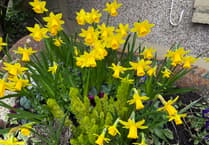A famous Monmouthshire writer who really appreciated the magic of this county was Arthur Machen (1863-1947). Born on 3 March, 1863, at 33 High Street Caerleon, he was the son of John Edward Jones, an Anglican priest who became vicar of Llandewi Church, which is now a private house situated just outside Caerleon.

Machen was Arthur’s mother’s maiden name and he adopted it as a nom de plume when he became a serious writer. He was raised in the Llandewi rectory, and this was near enough for him to frequently visit Caerleon by walking across the fields and through woods, to then wander through the streets of this very special little town.
From a young age, he was infatuated with the county’s brooding landscape, and Just like the writer Fred Hando, he preferred the ancient name Gwent, because of its association of Celtic, Roman and medieval history.
Although, Machen moved to London, to pursue a career in journalism, he frequently returned to Monmouthshire and clearly missed it very much. His birthplace in Caerleon, situated opposite the old Bull Inn car park is marked with a blue plaque
His writing was influenced by Edgar Allan Poe, Robert Louis Stevenson and Charles Dickens, and he became a leading Welsh author during the 1890s and early 20th century. He was best known for supernatural fantasy and horror fiction, but Monmouthshire, where he grew up was still an important part of his imaginative vision.
Throughout his life he had a deep love for his native county, and this is strongly expressed in his two autobiographical books, ‘Far off Things’ and ‘Things Near and Far’. For example, he recalls how he had seen ‘the sky above the dark stretch of Wentwood forest redden to the dawn, and how he lost his way ‘and strayed in a maze of unknown brooks and hills and woods and wild lands in the blackest hours after midnight.’
Even when living in London, he would spiritually wander ‘in deep and green Llandewi lanes’, and imagine seeing ‘the sun sink in fire behind Twyn Barlwm. This meant that in his heart, he ‘would always be a man of Gwent, with strong personal memories of ‘a realm of enchantment where the present and the past are one and the invisible and the eternal intertwine.’
He was greatly influenced by Caerleon’s Roman past, and this is shown in his book ‘Far Off Thing’s , in which he comments: ‘I shall always esteem it as the greatest piece of fortune that has fallen to me, that I was born in that noble town of Caerleon-on-Usk, in the heart of old Gwent. For the older I grow, the more firmly I am convinced that anything which I may have accomplished in literature is due to the fact that when my eyes were first opened in earliest childhood, they had before them a vision of an enchanted land.’
He describes Caerleon as the ‘little silent, deserted village that was once ‘the golden Isca of the Roman legions, that is golden for ever and immortal in the romances of King Arthur and the Grail and the Round Table.’
In his book Hill of Dreams (1907), he recalls how: ‘The evening smoke of the little town hung haze-like over the ragged roofs and mingled with the river mist and I saw the points of light start out suddenly from the cottages on the hillside beyond, and gazed at the long lovely valley fading in the twilight. The moon swam up through the film of misty cloud, and hung, a golden glorious lantern, in mid-air.’
From the windows of the Rectory, where he spent his childhood, he recalled how: “On fair clear days one could see the pointed summit of the Holy Mountain by Abergavenny. It would shine, I remember, a pure blue in the far sunshine; it was a mountain peak in a fairy tale.
:And then to eastward from the bedroom window of Llandewi Rectory, I looked over hill and valley, over high woods, quivering with leafage… to the church tower on the hill above Caerleon. Through a cleft one might see now and again a bright yellow glint of the Severn Sea, and the cliffs of Somerset beyond, and hardly a house in the landscape, look where you would.”
He particularly enjoyed looking towards the distinctive tump of Twyn Barlwm and the Mynydd Maen ridge stretching to Pontypool and beyond. Long before Llandegfedd Reservoir was established to flood the upper Soar Valley, Machen would have explored the local lanes and footpaths, for he comments: ‘We have tramped about hill and dale, by mountains and river through this delicious land to our heart’s content. We have tasted of the native beverages, beer and cider: we have laughed, sung, and joked in a thoroughly Silurian manner.’

In his biography, ‘Far off Things’ he recalls a walk ‘into that most wonderful, enchanted, delicious road that winds under the hillside under deep Wentwood, above the solemn curves of the river. We passed Bulmore where once a retired officer of the 2nd Augustan Legion had his villa, and here in the orchard, as they were planting some young trees, they found the stone inscribed: ‘Ave Julia, carissima conjux, in aeternum vale’ (Hail, Julia, dearest wife: farewell for ever).
“We went on our way by the river and passed under Kemeys, a noble, grey old house, with mullioned windows and Elizabethan chimneys. There is such peace about this place, such a sweetness from the wood, such a refreshment from the water, so grave a repose on it.”
With regard to our many historic manor houses, Machen commented: ‘They are noble old places, even though they are noble in a humble way; there are no Haddon Halls in Gwent, but these old houses of the small gentry of the borderland – now for the most part used as farmhouses – show their lineage in the display of their proportions, in the carved armorial bearings of their porches. The pride of race that belonged to the Morgans, Herberts, Meyricks that once lived in them has passed into their stones, and still shines there.’
In 1944, he wrote the introduction to Fred Hando’s book ‘The Plesasant Land of Gwent’, and commented: ‘Mr Hando has told us what really happened in my native and most beloved land of Gwent. I have flourished a little about it in my day, when my pen moved more glibly than now. I have tried here and there to make the page utter the awe and delight with which, by hills and woods, by deep ferny overshaowed lanes, I first came from Llandewi Rectory on the level of Tredonoc, and there saw, at a turn of the road, suddenly in a moment, Wentwood, green, great and exalted; the silvery winding of the river, and the vast peace of the still valley.. while Caerleon in the sunshine amongst the green meadows, and the Usk, here as tawny as the Tiber. About it; and in the west, the rounded height of the mountain, and the eminence of the tumulus of Twyn Barllwm, looking over sea and land.’
Arthur Machen, aged 84 died at Beaconsfield, Buckinghamshire, on 15 December 1947.




